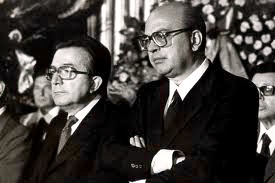
This year Italy will remember the fortieth anniversary of the infamous Law No. 194 that introduced abortion. This law is unique in the world. While in every other country abortion was introduced by the Left, in Italy it was the doing of the Christian Democrat Party.
A Long and Sad Story
To understand the origins of the Law No. 194, we have to take a quick look at the history of Italy in the post-War period.
In 1945, Italy was governed by a left-wing coalition that included the Communist, Socialist and Christian Democrat parties. The Christian Democrat Party had been founded the previous year by Alcide De Gasperi, who defined it as “a centre Party that moves to the Left.” In other words, it would take its votes from the Catholics, and then push them towards the Left. This was the outcome of a long-standing infiltration, inside the Church and in the laity, of the Progressive current that had been condemned by Pope Saint Pius X some decades before. In 1948, the Christian Democrat Party won the elections, initiating a long period of political supremacy.
Learn All About the Prophecies of Our Lady of Good Success About Our Times
In this period, in which the Christian Democrats dominated Italian politics, the country began a downward slope towards the Left: in 1950, Land Reform expropriated from the landowners; in 1954, the Party declared itself “laic,” thereby rejecting the Church’s Magisterium; in 1962, the Party approved the so-called “svolta a sinistra” (leftward turn); in 1963, it admitted the Socialists in the Government; also in 1963, it approved a new education system that favored secularism; in 1970, it approved divorce; in 1975, it approved a “New Family Law” that destroyed the foundations of the family; in 1976, it invited the Communists to the Government. The stage was set for the law on abortion.
The starting point was a sentence of the Constitutional Court, in February 1975, distinguishing between baby and fetus. Only the first one is protected by the Law. Immediately, Parliament established a Commission to draft a new law on abortion. In 1976, conservatives raised an “exception of constitutionality,” that is, objected to the law as being unconstitutional. The exception was rejected with the votes of the Communist, Socialist, Radical and Christian Democrat parties.

In July 1976, there was a chemical accident in Seveso, near Milan. A dioxin cloud was released from a faulty factory. It was said that the population had been poisoned and that pregnant women risked giving birth to deformed babies. Although the scientific basis for this was never established, the Christian Democrat government, lead by Giulio Andreotti, authorized eugenic abortions, in fact going against the existing law.
Eugenics: Anencephalic Fetuses Are Subhuman “Par Excellence,” Anthropologist Says
After a short debate in Parliament, on January 21, 1977, Communists, Socialists, Radicals and Christian Democrats joined forces and approved the Law No. 194, 310 votes against 296. The Senate then approved it 160 to 148. Conservatives immediately raised, for the second time, an exception of constitutionality. And for the second time they were turned down by the Andreotti Administration. When the Law was finally published, in May 1978, it bore the signatures of President Giovanni Leone, Prime Minister Giulio Andreotti, and five ministers—all Christian Democrats.
The New Legal Frame
What are the contents of the Law No. 194?
According to the previous legal frame, abortion was outlawed. Indeed, according to Title X Book II of the Penal Code, it was punished with a prison term of up to five years for anyone who induced or executed an abortion on a consenting woman, or up to seven years if it was on a non-consenting woman. However, according to Art. 54 of the same Code, there were some exceptions, like for example, in case of a health risk for the mother.
Law No. 194 turned this legislation upside down by declaring abortion legal, albeit with certain restrictions. The law arbitrarily divides the intra-uterine life of the baby in three periods, applying for each one a different ruling, and having as sole criterion the mother’s health, without any reference to the rights or to the well-being of the baby. The baby is a non-entity, a thing the mother can dispose of at will. This introduces a legal logic that, in fact, permits a woman to perform an abortion almost up to the ninth month.
10 Razones Por las Cuales el “Matrimonio” Homosexual es Dañino y tiene que Ser Desaprobado
Fortunately, Law 194 accepts the conscientious objection. Any medic or paramedic personnel can declare himself a conscientious objector, and thus refuse to perform abortions. This, in fact, is currently the only escape valve for pro-life doctors and nurses. Thank God, the number of conscientious objectors is very high. Almost 70% of Italian gynecologists refuse to kill babies. In some regions, especially in the South, this number can reach 80%. In the Autonomous Region of Trentino-Alto Adige (Südtirol), 92% of the doctors are objectors. This is why the abortionists are now trying to abrogate this article of the law.
Some maintain that Law No. 194 is “a good law wrongly applied.” In fact, as we saw, the law turned the previous legislation upside down, by declaring abortion legal. On the other hand, the few restrictions it contains are easily circumvented, since the ruling criterion is the mother’s health, not the baby’s rights.
The 1981 Referendum
In Italy there is no proposing referendum but only abrogative referendum. In other words, using the democratic instrument of a referendum, citizens cannot propose a new law, but can only abrogate an existing one, either partially or totally.
Right after the approval of Law No. 194, the Radical Party began to gather signatures in order to abrogate the restrictive articles, whereby turning abortion totally free. Immediately, the pro-lifers, including the association I currently preside—Tradizione Famiglia Proprietà—formed the Alleanza per la Vita (Alliance for Life), and began gathering signatures to abrogate the law itself. It was called the “maximalist proposal.”
Unfortunately, with rare exceptions, this pro-life initiative was not supported by Church officials. The reasons for this are manifold and would demand another article to explain. On the one hand, the Church in Italy was intimately associated with the Christian Democrat Party, as part of an extensive and complicated balance of powers few people wanted to alter.
Learn All About The Encyclical that Condemned the Sexual Revolution
On the other hand, the Progressive infiltration in the Church had already reached a climax. While no Italian bishop openly supported abortion, most were favorable to some sort of “modernization,” which implicitly meant more sexual freedom. Thus, directly or indirectly, they promoted the liberal mentality that was at the base of the abortion movement.
To this we have to add the utter rejection of militancy. The Vatican Council, they said, had inaugurated a new, friendly, relationship between the Church and the world. Catholics should no longer be “against” the world, they rather had to “dialogue” with it. And if abortion was part of this modern world, Catholics could not oppose it militantly. Msgr. Luigi Maverna, Secretary of the Italian Bishops’ Conference (CEI), refused to meet with representatives of the Alleanza per la Vita. He stated that the CEI was “wholly indisposed” to collaborate in the pro-life campaign. In May 1980, Alleanza representatives were received by Msgr. Achille Silvestrini, Secretary for General Affairs of the Vatican. He, too, was indisposed. He pointed to the “total inopportunity” of the abrogative referendum, and said they did not want Catholics to enter into any polemic with the abortionists. He also held the Christian Democrat Party was against such a referendum. This is hardly surprising, since it was them who had voted the law….
Unperceived Ideological Transshipment and Dialogue
While the Alleanza per la Vita campaign was thus seriously impaired, the CEI promoted the foundation of the Movimento per la Vita (Movement for Life), which presented two referendum proposals, called “minimalist.” These proposals were deemed immoral by top Roman theologians, because they:
- confirmed the legalization of therapeutic abortion up to the ninth month;
- confirmed the public funding of abortion;
- confirmed the duty of medical personnel to execute an abortion “in any case”;
- accepted contraception.
The appearance of the Movimento per la Vita, with such unacceptable proposals, was a bombshell. It sent Catholics into utter disarray. This disarray was heightened when, in February 1981, the Constitutional Court dismissed the Alleanza’s proposal, while accepting those of the Radical Party and of the Movimento per la Vita. Italian Catholics were disoriented. Some bishops even threatened canonical sanctions against the pro-life campaign.
There was also much confusion about the abrogative nature of the referendum. A “Yes” vote meant: “No, I do not want abortion.” A “No” vote meant: “Yes, I want abortion.” It is known that millions of Catholics, uninformed about this, voted “No” thinking they were voting against abortion.
10 Reasons Why Abortion Is Evil
Under such unfavorable circumstances, the referendum was held on May 17, 1981, while Pope John Paul II was in the hospital after the attempt against his life. Abortion won 68% to 32%.
The Progressive factions in the Church pointed to this result as a proof that the world was going in the opposite direction of traditional morals, and that, therefore, it was useless to continue to fight. Pro-life leaders, instead, pointed out that they were to blame for the disaster. Not only did they refuse to fight the battle, but actually boycotted those who wished to fight. In other words, they wanted to lose the battle, and they lost it.
Remembering the fortieth anniversary of the infamous Law No. 194 we would like to render homage to the pro-life leaders who, against enormous odds, carried on the referendum campaign. And, at the same time, point out how the “dialoguing” tactics are the shortest path to defeat.

